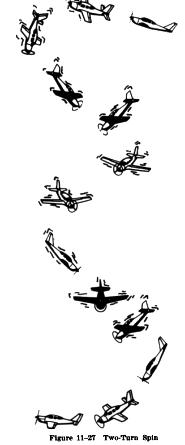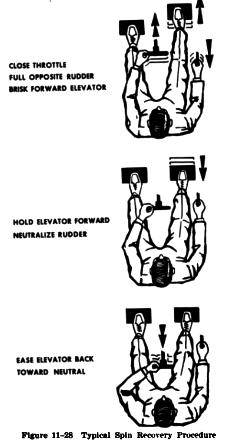Spins
Spins
 |
A spin may be described as an aggravated stall that results in what
is termed "autorotation" wherein the airplane follows a corkscrew path
in a downward direction. The wings are producing some lift and the airplane
is forced downward by gravity, wallowing and yawing in a spiral path (Fig.
11-27). It has been estimated that there are actually many factors contributing
to spinning, and in fact the spin is not very amenable to theoretical analysis.
Industry and the Federal Aviation Administration have and continue to
support studies directed at ways to design safer airplanes. Spin analysis
continues to be a major consideration in these studies. Fear of and aversion
to spins are deeply rooted in the public's mind, and many pilots have an
unconscious aversion to them. If one learns the cause of a spin and the
proper techniques to prevent and/or recover from the spin, mental anxiety
and many causes of unintentional spins may be removed.
Though instruction in spins is not required of applicants for private
or commercial pilot certificates, applicants for a flight instructor certificate
with an airplane or glider instructor rating may be asked to demonstrate
that they can recognize and recover from spin situations that might be
encountered in poorly executed maneuvers during student training flights.
For this reason, a brief discussion of spins is included in this handbook.
The INTENTIONAL SPINNING of an airplane for which the spin maneuver
is not specifically approved is NOT authorized either by this handbook
or by Federal Aviation Regulations. Official sources for determining if
the spin maneuver is approved for a specific airplane are: |
a. In the airplane's Type Certificate
and Data Sheets;
b. On a placard located in clear view
of the pilot in the airplane, i.e., "NO ACROBATIC MANEUVERS INCLUDING SPINS
APPROVED"; and
c. The maneuvers section of the FAA
Approved Airplane Flight Manual or Pilot's Operating Handbook.
Increasing occurrences involving airplanes wherein spin
restrictions are intentionally ignored by pilots, have been brought to
the attention of the FAA. Despite the installation of placards prohibiting
intentional spins in these airplanes, a number of pilots, including some
flight instructors, attempt to justify the maneuver, rationalizing that
the spin restriction results merely because of a "technicality" in the
airworthiness standards.
Some pilots reason that the airplane was spin tested during
its certification process and, therefore, no problem should result from
demonstrating or practicing spins. The fact that certification in the Normal
category requires only the airplane recover from a one turn spin in not
more than one additional turn or 3 seconds, whichever takes longer. This
same test of controllability can also be used in certificating an airplane
in the Utility category (FAR 23.221(b)).
The point is that 360 degrees of rotation (one turn spin)
does not provide a stabilized spin. If the airplane's controllability has
not been explored by the engineering test pilot beyond the certification
requirements, prolonged spins (inadvertent or intentional) in that airplane
places an operating pilot in an unexplored flight situation. Recovery from
it may be difficult or even impossible.
In FAR Part 23, "Airworthiness Standards: Normal, Utility,
and Acrobatic Category Airplanes," there are no requirements for investigation
of controllability in a true spinning condition for the Normal category
airplanes. The one turn "margin of safety" is essentially a check of the
airplane's controllability in a delayed recovery from a stall. Therefore,
in airplanes placarded against spins there is absolutely no assurance whatever
that recovery from a fully developed spin is possible under any circumstances
(Fig. 11-23).
The occurrence of uncontrollable flat spins in some airplanes,
resulting form intentionally exceeding the one turn safety margin, leads
the FAA to believe that some pilots are unaware of the inherent risk involved
in spinning an airplane which has been placarded to prohibit spins. Based
on experience to date, it is possible that a number of pilots will at one
time or another, intentionally ignore the spin limitation because of lack
of knowledge, misinformation, or misinterpretation regarding the intent
of applicable airworthiness standards in FAR Part 23.221, relating to spins.
Since those pilots may be expected to have little or no knowledge regarding
the possible development of an insidious flat spin, they will be unaware
of the serious risks incurred. Accordingly, all pilots are cautioned to
adhere strictly to the spin restrictions in airplanes placarded against
intentional spins.
THE PILOT OF AN AIRPLANE PLACARDED AGAINST INTENTIONAL
SPINS SHOULD ASSUME THAT THE AIRPLANE MAY BECOME UNCONTROLLABLE IN A SPIN.
It has been estimated that there are actually several hundred
factors that contribute to spinning. From this it is evident that, whether
or not spinning is a desirable maneuver or characteristic, it will be a
feature of airplanes for some time to come and must be reckoned with in
the training of a pilot.
Many modern airplanes have to be forced to spin and require
considerable judgment and technique to get the spin started. Paradoxical
as it may seem, these same airplanes that have to be forced to spin, may
be accidentally put into a spin by mishandling the controls in turns, stalls,
and flight at minimum controllable airspeeds. This fact is additional evidence
of the necessity for the practice of stalls until the ability to recognize
and recover from them is developed.
Often a wing will drop at the beginning of a stall. When
this happens the nose will attempt to move (yaw) in the direction of the
low wing. This is where use of the rudder is important during a stall.
The correct amount of opposite rudder must be applied to keep the nose
from yawing toward the low wing. By maintaining directional control and
not allowing the nose to yaw toward the low wing, the wing will not drop
farther before the stall is broken, ant thus a spin will be averted. If
the nose is allowed to yaw during the stall, the airplane begins to slip
in the direction of the lowered wing, and as it does, the air meeting the
side of the fuselage, the vertical fin, and other vertical surfaces, tends
to "weathervane" the airplane into the relative wind. This accounts for
the continuing yaw which is present in a spin.
At the same time, rolling is also occurring about the longitudinal
axis of the airplane. This is caused by the lowered wing having an increasingly
greater angle of attack, due to the upward motion of the relative wind
against its surfaces. This wing, then, is well beyond the stalling angle
of attack, and accordingly suffers an extreme loss of lift. The rising
wing, since the relative wind is striking it at a smaller angle, has a
smaller angle of attack than the opposite wing. Thus, the rising wing has
more lift than the lowering wing, so that the airplane begins to rotate
about its longitudinal axis. This rotation, combined with the effects of
centrifugal force and the different amount of drag on the two wings, then
becomes a spin and the airplane descends vertically, rolling and yawing
until recovery is effected.
Continued practice in stalls will help the pilot develop
a more instinctive and prompt reaction in recognizing an approaching spin.
It is essential to learn to apply immediate corrective action any time
it is apparent that the airplane is nearing spin conditions. If an unintentional
spin can be prevented, it should be by all means. This is sound pilot judgment
and a positive indication of alertness. If it is impossible to avoid a
spin, the pilot should execute an immediate recovery - the controls must
not be held with the spin.
The first corrective action taken during any power on spin
is to close the throttle. Power aggravates the spin characteristics and
causes an abnormal loss of altitude in the recovery.
Prior to spin demonstrations the FAA approved Airplane
Flight Manual or Pilot's Operating Handbook for the airplane being flown
should be consulted for the proper recovery technique. In the absence of
such recommendations, the following technique is suggested.
| To recover from the spin, the pilot should first apply full opposite
rudder; then after the rotation slows, apply brisk, positive straight forward
movement of the elevator control (forward of the neutral position) (Fig.
11-28). The control should be held firmly in this position. The forceful
movement of the elevator will decrease the excessive angle of attack and
thus will break the stall. When the stall is broken the spinning will stop.
This straight forward position should be maintained and as the spin rotation
stops, the rudder should be neutralized.
If the rudder is not neutralized at the proper time, the
ensuing increased airspeed acting upon the fully deflected rudder will
cause an excessive and unfavorable yawing effect. This places great strain
on the airplane, and may cause a secondary spin in the opposite direction.
Slow and overly cautious control movements during spin recovery must
be avoided. In certain cases it has been found that such movements result
in the airplane continuing to spin indefinitely, even with the application
of full opposite controls. Brisk and positive operation, on the other hand,
results in a more positive recovery.
After the spin rotation stops and the rudder has been neutralized,
the pilot should begin applying back elevator pressure to raise the nose
to level flight. Caution must be used so as not to apply excessive back
pressure after the rotation stops. Sometimes a pilot does this because
of being too anxious to stop the descent. To do so will cause a secondary
stall and may result in another spin, more violent than the first. |

|
Any time a spin is encountered, regardless of the conditions, the normal
spin recovery sequence should be used: (1) retard power; (2) apply opposite
rudder to slow rotation; (3) apply positive forward elevator movement to
break stall; (4) neutralize rudder as spinning stops; and (5) return to
level flight.
Following training in spins, the pilot should recognize
when a spin condition exists and take prompt action to prevent a fully
developed spin. Performance is considered unsatisfactory if more than one
turn of a spin occurs or if it becomes necessary for the instructor to
take control of the airplane to avoid a fully developed spin.

